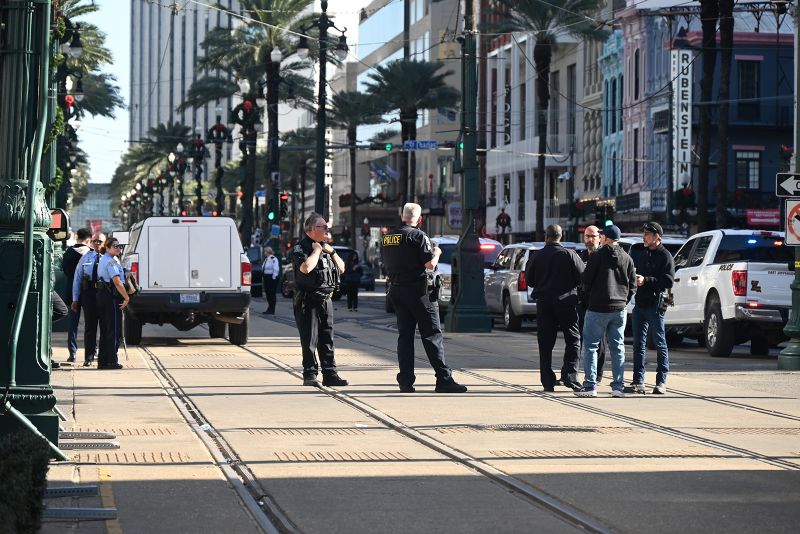
New Orleans ramps up security as Mardi Gras season begins and Super Bowl approaches, but concerns and questions remain
As New Orleans prepares to kick off its extravagant Carnival season this week, the city is asking for federal help in ensuring there is not a repeat of the horrific truck-ramming that killed 14 people early on New Year’s Day.
President Joe Biden is set to visit on Monday and is expected to hear directly from Mayor LaToya Cantrell and other city officials on what Washington can do, including potentially raising the federal security level for its world-famous Carnival, also called Mardi Gras.
The New Year’s attack came during a busy season for New Orleans; at the time, revelers were still celebrating on the raucous Bourbon Street, with the Allstate Sugar Bowl scheduled later that day, though it was later postponed. The city had also been gearing up for Carnival, with weeks of parades, performances and parties starting Monday. And in February, the crown jewel of American sports: Super Bowl LIX.
Each event is expected to draw huge numbers of visitors from across the country. Local businesses including restaurants and hotels are preparing for the influx of tourists with special deals and events.
But it also poses a security challenge that authorities are now under pressure to address, facing heightened scrutiny as questions swirl about how the attack was carried out and whether it could have been prevented.
Shortly after the attack, Louisiana Gov. Jeff Landry declared a state of emergency, writing in the decree that it would allow New Orleans to deploy additional resources as it prepares to see “hundreds of thousands of visitors in the weeks leading up to the Super Bowl and Mardi Gras.”
“Extensive coordination and security measures are necessary to secure areas around the events and ensure public safety from the threats associated with these events,” he wrote.
And on Sunday, Mayor Cantrell said the city had requested federal assistance in asking a tactical expert to map out the city and determine what weak spots could be targeted or might need further security. Authorities will also ask an expert to determine whether existing security measures, such as their road barriers and barricades are sufficient, she said – after the attacker drove his pickup truck onto the sidewalk, bypassing the police barrier.
“If they’re not (sufficient), how and what, and where do they need to be placed?” she said. “This is a work in progress, and we’re committed to doing everything necessary to ensure public safety measures.”
Cantrell also said she had submitted a federal request for Mardi Gras to be upgraded in federal security tier, from SEAR 2 to SEAR 1 – something she had been pushing for many years.
The Special Event Assessment Rating (SEAR) designation and five-tiered ranking system determine whether events require federal security support such as field intelligence teams, air security, bomb detection dogs and more. The Super Bowl has been designated SEAR 1, the top tier reserved for “significant events” with national or international importance requiring “extensive” support.
New Orleans police are also stepping up measures, saying they had a “comprehensive security plan in place” for the first parade scheduled Monday and for all parades going forward.
The road barriers
One of the main points of the New Year’s attack investigation will be why there were no strong barriers to protect revelers in the city’s bustling French Quarter that day.
The issue had been spotlighted years ago, when a private security consulting firm warned in a 2019 report that the risk of terrorism in the French Quarter – specifically mass shootings and vehicular attacks – remained “highly possible while moderately probable.”
The report “strongly recommends” safety structures known as bollards –– vertical posts that can move up and down –– be fixed and improved “immediately.”
New Orleans Police Superintendent Anne Kirkpatrick said she did not know the city owned the safety devices, which have since been put in place.
“With the Super Bowl on the horizon, it was important to have those bollards installed, but no less important was the Sugar Bowl and New Year’s Eve,” Morrell added.
“I mean, New Orleans is a destination for pretty much every holiday you can imagine, so having those bollards available – and even more importantly, not having hardened infrastructure even temporarily there instead of the bollards as they’re placed throughout the Quarter – is problematic.”
FBI investigations
In a briefing on Sunday, the FBI revealed that the attacker, Shamsud-Din Jabbar, had visited New Orleans twice in the months prior and used Meta smart glasses to film the street and plan the attack.
He had stayed at a rental home in New Orleans from October 30 for a few days, and during that time recorded video as he bicycled through the French Quarter, said FBI New Orleans Special Agent in Charge Lyonel Myrthil. Jabbar also visited New Orleans on November 10, and investigators were still putting together the details of that trip.
During the news conference, officials released videos of his actions hours before the attack and provided a timeline of his movements – including details of Jabbar setting fire to an Airbnb and placing improvised explosive devices (IEDs) on Bourbon Street.
Investigators are also looking into Jabbar’s trips to Egypt and Canada, and other visits to Atlanta and Tampa. He traveled to Cairo from June 22 to July 3, 2023, and visited Ontario from July 10 to July 13, 2023, Myrthil said. FBI agents are digging into what he did on those trips and whether they tie into the attack.
All 14 of the victims from the New Year’s attack have now been identified and named. The final victim identified was Latasha Polk, a certified nursing assistant and mother of a 14-year-old, Gov. Landry said in a news conference.
